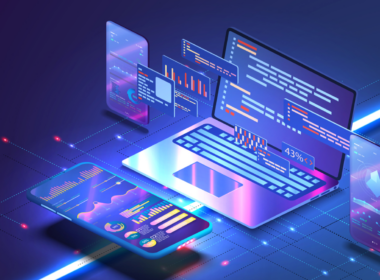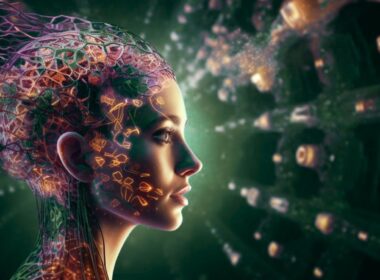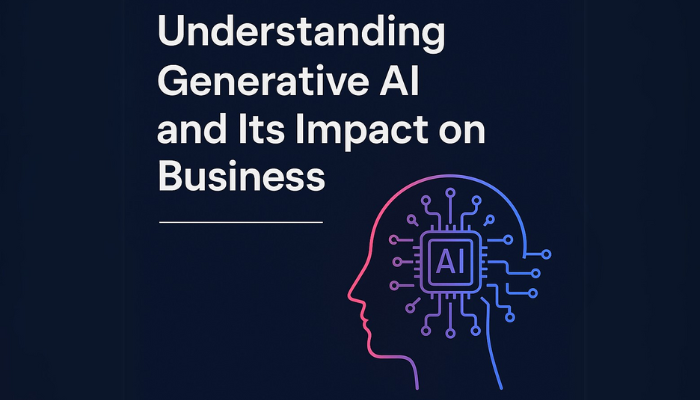Many businesses struggle to understand how different types of artificial intelligence can benefit them. The rapid growth of AI technologies has created confusion around what traditional AI does versus what generative AI can achieve. This lack of clarity can delay adopting the right solutions and limit business growth.
Worldwide Spending on Artificial Intelligence Forecast to Reach $632 Billion in 2028 with generative AI driving a significant part of this expansion. Knowing the difference between AI and genai helps organizations choose technologies that fit their needs and goals.
In this blog, you’ll learn what sets traditional AI and generative AI apart, how each is applied in real-world scenarios, and what challenges and benefits come with their adoption. This knowledge is essential for any business looking to implement AI effectively.
What is Artificial Intelligence (AI)?
Artificial Intelligence, or AI, refers to computer systems designed to simulate human intelligence. These systems perform tasks such as learning from data, reasoning to draw conclusions, and solving complex problems without explicit programming for every scenario. Essentially, AI enables machines to mimic cognitive functions that humans perform naturally.
AI can be broadly categorized into two types: narrow AI and general AI. Narrow AI is specialized in performing specific tasks like voice recognition, image classification, or recommendation engines and is what powers most of today’s AI applications. General AI, which remains largely theoretical, would involve machines possessing human-level intelligence capable of performing any intellectual task.
Common AI applications include:
- Predictive analytics: AI analyzes historical data to forecast trends, demand, or risks.
- Automation: Automating repetitive, rule-based tasks to improve efficiency.
- Natural language processing (NLP): Understanding and generating human language for chatbots, virtual assistants, and translation tools.
- Computer vision: Interpreting visual information for applications like facial recognition or quality inspection.
The underlying approach often involves rule-based systems combined with machine learning models that learn patterns from data. These data-driven methods allow AI to improve over time with more exposure, adapting to new information and scenarios without explicit reprogramming.
What is Generative AI (GenAI)?
Generative AI is a specialized subset of AI focused on creating new content by learning patterns from existing data. Unlike traditional AI systems that analyze or classify input, generative AI produces original outputs such as text, images, audio, or code that resemble the data it was trained on.
Popular generative AI examples include ChatGPT, which can write essays or answer questions; DALL·E, which creates images from text descriptions; and code generation tools that assist developers by producing software snippets.
The primary difference in function is that generative AI is designed to create novel content rather than simply analyze or interpret existing data. This capability allows for interactive and creative applications that traditional AI models do not provide.
With a clear understanding of both concepts, let’s examine the key differences between AI and generative AI to see how each serves distinct roles in technology and business.
Capabilities and Applications for Both AI and Generative AI
Understanding the difference between ai and genai begins with examining their distinct capabilities and practical applications across industries.
1. Artificial Intelligence (AI)
Artificial Intelligence (AI) primarily focuses on interpreting data to automate processes, detect patterns, and support decision-making. Its capabilities include:
- Predictive Analytics: Analyzing historical and real-time data to forecast trends such as customer behavior, equipment failures, or market demand.
- Automation: Performing repetitive and rule-based tasks efficiently, such as invoice processing, customer service workflows, or inventory management.
- Natural Language Processing (NLP): Enabling machines to understand, interpret, and respond to human language in tasks like chatbots or document analysis.
- Computer Vision: Extracting meaningful information from images or videos for quality inspection, security monitoring, or autonomous navigation.
These capabilities find applications in sectors such as finance for fraud detection, healthcare for diagnostics support, retail for personalized recommendations, and manufacturing for quality control.
2. Generative AI (GenAI)
Generative AI (GenAI) is an advanced form of AI designed to create new content such as text, images, or code by learning from large datasets, enabling creative outputs that traditional AI cannot produce
- Content Generation: Producing written text, marketing copy, reports, or creative writing based on prompts or contexts.
- Image and Video Creation: Generating realistic images, designs, or animations that can be customized for branding or product prototyping.
- Code Synthesis: Assisting developers by generating code snippets or entire functions, speeding up software development cycles.
- Conversational Agents: Enabling more natural, context-aware interactions with users through chatbots and virtual assistants.
Generative AI is transforming industries such as media and entertainment, marketing, software development, and customer support by accelerating creativity and improving engagement.
While traditional AI excels at improving existing processes through analysis and automation, generative AI introduces new possibilities by producing original content and interactive experiences. Selecting the right approach depends on your specific business goals, whether you need to optimize operations or create innovative outputs.
Key Differences Between AI and Generative AI
Understanding the difference between AI and genAI is essential for businesses and technology leaders seeking to adopt the right solutions for their needs. While both fall under the broader artificial intelligence umbrella, they serve fundamentally different purposes, operate on varied data inputs, and provide distinct outputs and user experiences.
Purpose and Functionality
Traditional AI helps automate specific business tasks by analyzing large volumes of data and identifying patterns for decision-making, predictive analysis, and operational efficiencies Its primary function is to assist or replace human decision-making processes by providing insights or executing predefined operations. Examples include fraud detection systems that flag suspicious transactions or voice recognition software that converts speech into text.
In contrast, generative AI is designed to create new content that did not previously exist. This content can be textual, visual, or auditory, often mimicking the style and structure of the training data it was exposed to. Generative AI enables creative applications such as writing articles, generating images, composing music, or producing software code, offering a level of originality absent in traditional AI.
Input and Output
Traditional AI systems process input data primarily to classify, detect anomalies, or make informed decisions based on learned patterns. The outputs are usually actionable insights, categorizations, or predictions tied closely to the input data.
Generative AI, however, uses large volumes of training data to understand underlying patterns and statistical distributions, then produces entirely new content that reflects these patterns. For example, a generative AI model trained on text can generate paragraphs of writing that appear original yet are coherent and contextually relevant.
Use Cases
Traditional AI Applications
- Fraud Detection in Financial Transactions: AI detects fraudulent activity by analyzing transaction data in real time. For example, multiple large withdrawals from different locations can trigger alerts or block transactions until further verification, enhancing security and reducing fraud risks.
- Voice and Facial Recognition: AI systems use voiceprints and facial features for security and customer service. Voice recognition powers virtual assistants, while facial recognition unlocks devices and controls access in secure areas. Both rely on pattern recognition and machine learning.
- Recommendation Engines in E-commerce: AI analyzes customer behavior to recommend products based on past purchases, preferences, or browsing history. Platforms like Amazon and Netflix use AI to personalize shopping or viewing experiences, boosting sales and satisfaction.
Generative AI Applications
- Automated Content Creation: Generative AI tools like Jasper AI or ChatGPT produce written, audio, or video content, saving time for marketers and creating high-quality material at scale. This is useful for digital marketing, where fresh content is crucial.
- Code Generation for Developers: Generative AI tools like Codewave help developers by suggesting code, reducing repetitive tasks and allowing them to focus on more complex problems.
- Design Prototyping: Generative AI tools such as DALL·E or MidJourney create design prototypes quickly. Designers can visualize website or app concepts, UI components, and logos, streamlining the design process and fostering creativity.
Complexity and Data Requirements
Traditional AI systems primarily rely on structured data, such as databases or spreadsheets, where information is organized and labeled for easy analysis. This makes it ideal for supervised learning models that recognize specific patterns or anomalies within well-defined categories. For decision-makers, this means traditional AI is excellent for tasks that require precision and accuracy, such as fraud detection, customer segmentation, and predictive analytics.
By using structured data, businesses can quickly implement AI solutions that improve operational efficiency, enhance decision-making accuracy, and automate repetitive tasks with a high degree of certainty.
Interaction and User Experience
Generative AI, on the other hand, requires vast, diverse, and often unstructured datasets such as text, images, and even audio. These models capture complex patterns and nuances that help them create new content. The data is not simply categorized but is used to help models generate new and original outputs. This ability allows businesses to use generative models for more creative tasks, like content generation, design, and even software development.
Generative AI opens up new opportunities for creativity and innovation. Whether it’s automating content creation, generating personalized marketing materials, or assisting in product design, businesses can save time and resources while producing high-quality, unique outputs that would be difficult or impossible to create manually.
Summary Table: Difference Between AI and Generative AI
| Aspect | Traditional AI | Generative AI |
| Purpose | Analyze data, make predictions, automate risks | Generate new, original content |
| Input | Structured or semi-structured data | Large, diverse datasets (often unstructured) |
| Output | Insights, classifications, decisions | Text, images, audio, code, creative content |
| Use cases | Fraud detection, voice recognition, recommendations | Content creation, code generation, design prototyping |
| Complexity | Requires labeled data, focused on pattern recognition | Requires massive data to learn complex patterns |
| User Interaction | Backend processing, limited direct interaction | Interactive, conversational, creative outputs |
Curious how AI and Generative AI can improve your operations? Codewave is here to guide you through every step. Contact us to learn more!
Having distinguished the core differences between traditional AI and generative AI, it is important to explore the unique challenges that come with their adoption.
Challenges and Solutions in AI Adoption
Implementing AI and generative AI comes with specific challenges that require thoughtful strategies to overcome:
1. Ethical Considerations
Both AI types face concerns over bias in data and potential misuse. For traditional AI, biased datasets can lead to unfair decisions, while generative AI risks creating misleading or harmful content. To address this, businesses should implement strict data governance policies, conduct regular audits, and adopt ethical AI frameworks that prioritize transparency and fairness.
2. Data Biases
AI models are only as unbiased as their training data. Mitigating bias requires diverse, representative datasets and continuous monitoring to detect and correct unfair patterns. Employing explainable AI techniques can help understand model decisions and ensure accountability.
3. Computational Resources
Generative AI, in particular, demands significant computational power for training large models, which can increase costs and environmental impact. Businesses can manage this by choosing scalable cloud-based AI platforms, optimizing models for efficiency, or starting with smaller prototypes to validate use cases before full deployment.
4. Implementation Complexity
Integrating AI solutions can be complex and require specialized expertise. Starting with clear business objectives and pilot projects helps manage risks and demonstrates ROI before scaling up. Collaboration with experienced AI partners can bridge technical gaps and accelerate adoption.
5. Practical Advice for Decision-Makers
Understanding your business needs is crucial. If your goal is to automate existing processes or gain operational insights, traditional AI offers proven capabilities. For innovation in content creation or customer interaction, generative AI presents new opportunities but requires careful oversight. Combining both technologies strategically can deliver comprehensive value.
With these considerations in mind, let’s explore how Codewave applies both traditional AI and generative AI technologies to build tailored solutions that meet your specific business objectives.
How Codewave Applies AI and Generative AI in Solutions
At Codewave, we recognize the distinct roles of traditional AI and generative AI, and how each can uniquely address your business challenges. By combining both technologies, we create customized solutions that fit your operational and creative needs.
1. Traditional AI Solutions: Driving Operational Efficiency
Our AI and machine learning development focuses on improving day-to-day business functions by:
- Automating complex workflows to reduce manual effort
- Enabling real-time decision-making through data analysis
- Predicting maintenance needs and demand fluctuations
- Improving accuracy and efficiency across sectors like healthcare, fintech, and logistics
2. Generative AI: Fueling Creativity and Innovation
On the creative front, Codewave builds advanced generative AI models that:
- Produce original content such as marketing copy and design prototypes
- Generate software code snippets to accelerate development cycles
- Help businesses reduce time-to-market for new products and services
- Enable personalized, dynamic customer engagement
3. Rapid Prototyping with AI Sprints
To quickly validate your AI ideas and minimize risks, we offer “sprints” a rapid service that helps you:
- Test AI and generative AI concepts with functional models
- Assess feasibility early in the development cycle
- Collect valuable feedback from stakeholders before full deployment
4. Tailored AI Solutions for Your Business
Whether you need operational tools powered by data-driven AI or innovative content generated by generative AI, Codewave works closely with you to:
- Align solutions with your strategic goals
- Deliver measurable business outcomes
- Support smooth and effective AI adoption
Discover how Codewave’s expertise in both AI and generative AI can transform your business. Contact us for a personalized consultation and explore tailored solutions designed for your needs.
Codewave is a UX first design thinking & digital transformation services company, designing & engineering innovative mobile apps, cloud, & edge solutions.







